손톱이 말하는 구강 전신 건강 (What fingernails say about oral-systemic health)
- ;.jpg [File Size:74.3KB]
- ㅣㅣㅣ.jpg [File Size:83.0KB]
- ;.jpg [File Size:74.3KB]
- 1.jpg [File Size:76.8KB]
- 2.jpg [File Size:29.7KB]
- 3.jpg [File Size:91.6KB]
- 4.jpg [File Size:76.4KB]
- 5.jpg [File Size:93.9KB]
- 6.jpg [File Size:54.8KB]
- 7.jpg [File Size:132.6KB]
Dec. 12, 2022 2022년 12월 12일
COVID nails? Muehrcke’s lines? The things you can learn about a patient with a look at their nails will surprise you.
COVID 손톱? Muehrcke’s line? 손톱을 보고 환자에 대해 알 수 있는 사실은 당신을 놀라게 할 것입니다.
Authors: Michele White, DDS, Bridget B. Huynh, Amber B. Hua, Royce Strickland, DDS, Cleverick (C.D.) Johnson, DDS, MS, Ben F. Warner, DDS, MD, MS
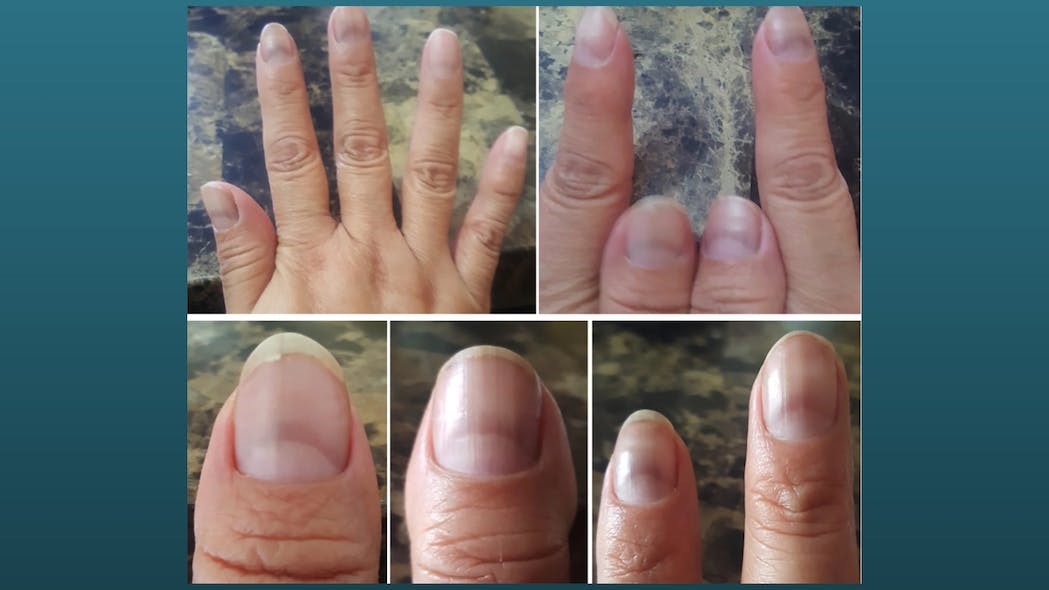
The new-patient dental exam, or complete oral exam, is an important aspect of the establishment of the relationship between the patient and the dental team. During this initial visit, it is the duty of dental personnel to gather information for the safe and effective treatment of the patient.
신규 환자의 치과 검진 또는 전반적인 구강 검진은 환자와 치과 의료진 간의 관계를 확립하는 중요한 요인입니다. 초기 방문 시 환자에 대하여 안전하고 효과적인 치료를 위하여 환자의 정보를 수집하는 것은 치과위생사의 의무입니다.
Along with the medical and dental history, extraoral and intraoral clinical exams are performed. Observation of clinical findings—and discerning whether they are within normal limits or atypical—launches the treatment planning phase. The fingernails, as a readily observable feature, can aid the dental hygienist and dentist when considering the patient’s overall health.
환자의 전신적인 병력, 치과 병력 함께 구강 외 및 구강 내 임상 검사가 진행됩니다. 임상 소견을 관찰하고 정상 범위 내에 있는지 비정상인지를 식별하여 치료 계획 단계를 수립합니다. 손톱은 쉽게 관찰할 수 있는 특징으로 치과위생사와 치과의사가 환자의 전반적인 건강을 고려할 때 도움이 될 수 있습니다.
A literature review of commonly found diseases that are clinically relevant and observed in the nails was conducted for this study. Dental professionals can observe features in the nails of their patients as an aid to assist them in differentiating their patients’ health. Following are examples of commonly found diseases that have presentation in the fingernails.
이 연구를 통하여 실제 임상에서 환자와 연관이 있었으며, 일반적으로 손톱에서 관찰되는 질병에 대한 문헌 검토를 수행 하였습니다. 치과위생사는 환자의 건강상태를 알아내는데 도움이 되는 보조 수단으로 환자의 손톱에서 특징을 관찰할 수 있습니다. 다음은 손톱에서 흔히 발견되는 질병의 예입니다.
Mees’ lines, Beau’s lines, Muehrcke’s lines
There are several atypical presentations of the nails that can suggest disease to the dental team; e.g., Beau’s lines, Mees’ lines, and Muehrcke’s lines (figures 1-3).1 Although they all present in a transverse horizontal manifestation, differences can be seen among these abnormalities.
치과의료진이 질병을 암시할 수 있는 몇 가지 비정상적인 손톱 모양이 있습니다. 예를 들어, Beau's line(Figure 1), Mees' line( Figure 2), Muehrcke's line( Figure 3) 모두 수평으로 가로모양의 줄로 나타나기는 하지만 이러한 비정상적인 손톱 사이에는 차이점이 있습니다.
Beau’s lines exhibit depressions or grooves that are the result of conditions that cause the nail to slow or stop growing. Both Mees’ lines and Muehrcke’s lines present as a white lesion in the nail bed.2 Only Beau’s lines and Mees’ lines move distally with nail growth.3 Beau’s lines, Mees’ lines, and Muehrcke’s lines are associated with systemic illness, trauma, poisoning, medications, and high-altitude mountaineering.2
Beau의 라인은 손톱이 늦게 자라거나 자라는 것을 멈추게 움푹 들어간 곳이나 홈을 나타납니다. Mees' line과 Muehrcke's line은 모두 손톱 밑에 흰색 병변이 보입니다. Beau's line과 Mees' line만이 손톱 성장과 함께 몸에서 멀어지는 부분으로 이동합니다. Beau's line, Mees' line, Muehrcke's line 은 전신 질환, 외상, 중독, 약물, 고지대 등산이 원인입니다.
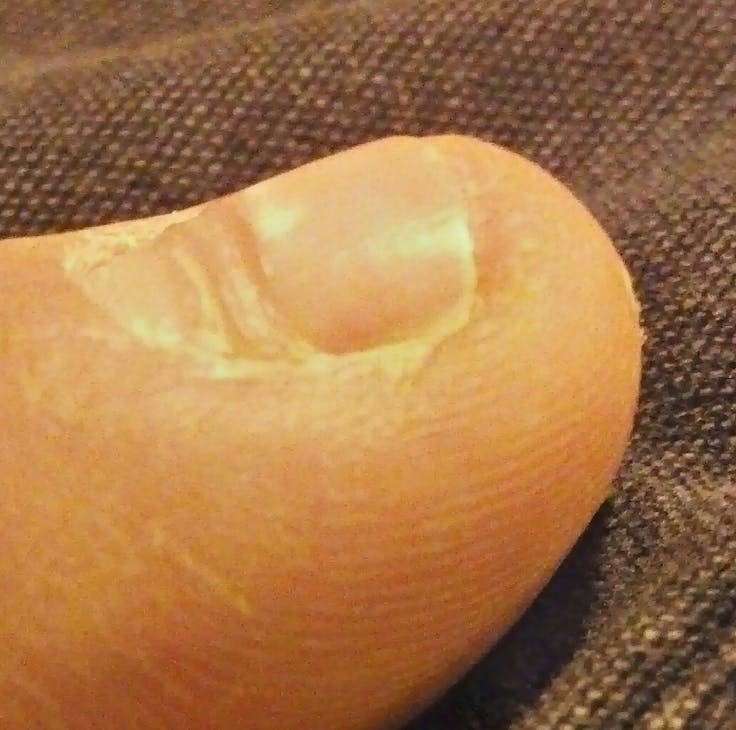
Figure 1. : Beau’s lines
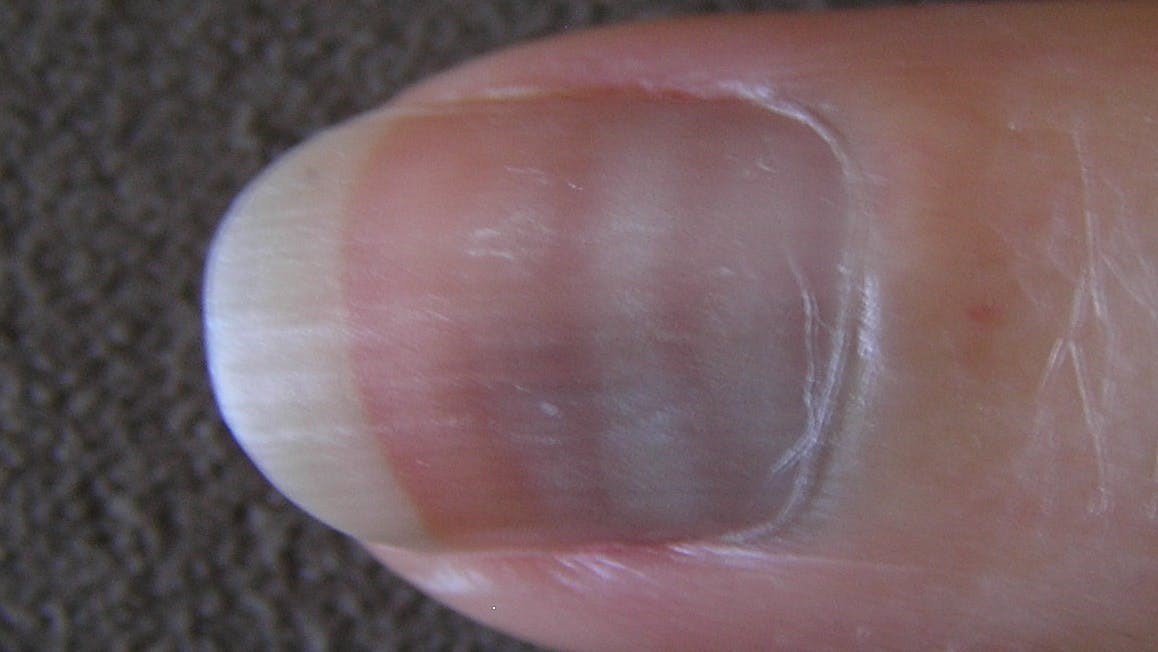
Figure 2. Mee’s lines
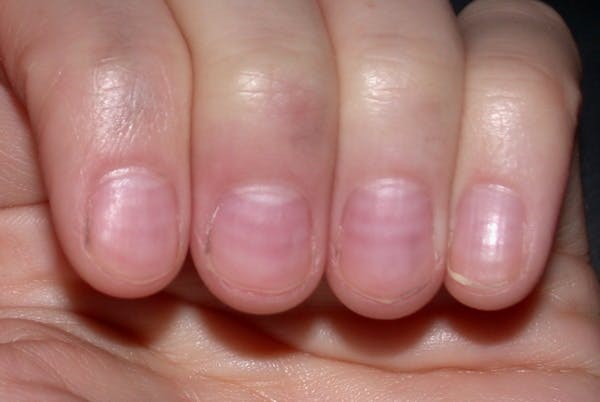
Figure 3. Chemotherapy-induced Muehrcke’s lines on a 28 year old female
COVID nails 코로나 손톱
With the onset of the SARS-CoV-2 (COVID-19) pandemic, mucocutaneous expression of illness presented and is still being documented.4 One such symptom presents in the nail beds and is referred to as COVID nail or COVID red half-moon nail (figure 4).4 COVID nail displays as a half-moon-shaped transverse red/violet band above the nail lunule5 with an onset as early as two days after COVID symptoms begin and as late as one month.6 Symptoms usually disappear once the patient has recovered from COVID-19.
SARS-CoV-2(COVID-19) 대유행이 시작되면서 질병의 점막 피부 발현이 나타났으며 현재도 보고 되고 있습니다. 이러한 증상 중에서 하나는 손톱 밑에 나타나며, COVID 네일 또는 COVID 레드 하프 문이라고 합니다(Figure 4). COVID 손톱은 COVID 증상이 시작된 지 2일 후부터 한달 까지 증상이 시작되는데 반달 모양 손톱 위에 가로줄로 빨간색/보라색 띠로 나타납니다. 환자는 COVID-19에서 회복 증상이 회복 되면서 일반적으로 사라집니다.
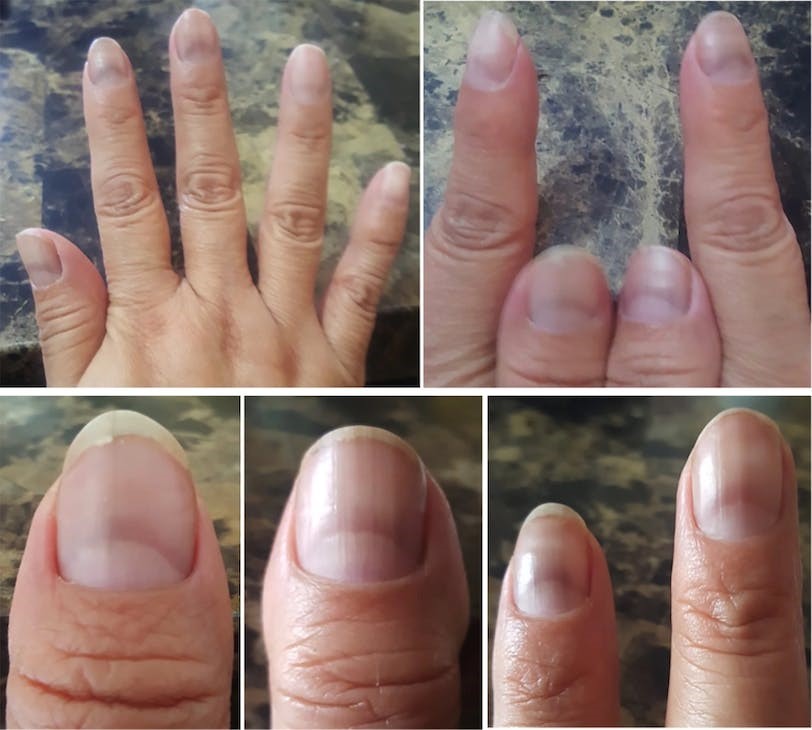
Figure 4 : Red half-moon nails associated with COVID-19 infection
Green nail syndrome 녹색 손톱 증후군
Another symptom of infection, green nail syndrome, occurs in the nail beds. It is seen most commonly as an occupational disease in health-care workers, especially in intensive care units, and lately, during the COVID-19 pandemic.7,8 Treatment includes topical and/or systemic antibiotics, diluted sodium hypochlorite, antifungals, and tobramycin eye drops.7
또 다른 감염 증상인 녹색 손톱 증후군은 손톱 밑에서 나타납니다. 특히 중환자실에서 일하는 의료종사자에게 나타났으며, 최근에는 COVID-19 대유행 기간 동안 의료진에게 직업병으로 가장 흔하게 나타납니다. 치료에는 국소 및/또는 전신 항생제, 희석된 차아염소산나트륨, 항진균제, 토브라마이신 안약이 포함됩니다.
Koilonychia 코일로니키아
Koilonychia is a convex, spoon-shaped aberration of the nail that is most often caused by iron-deficiency anemia (figure 5).9 Though considered the world’s most common nutritional deficiency disease, this symptom is often secondary to lack of folate, protein, or vitamin C. Other possible causes include autoimmune diseases, such as celiac disease, that cause an inability to absorb iron from food; hypothyroidism; low blood supply to the extremities; vitamin B deficiency; and cancer.10
Koilonychia는 철 성분이 결핍되면서 빈혈이 있는 환자에게 가장 흔히 발생하는 볼록한 숟가락 모양의 손톱 이상입니다(Figure 5). 세계에서 가장 흔한 영양 결핍 질환으로 여겨지지만 이 증상은 종종 엽산, 단백질 또는 비타민 C의 부족으로 인해 이차적으로 나타납니다. 또 다른 원인으로는 음식에서 철분을 흡수할 수 없게 만드는 셀리악병과 같은 자가면역 질환과 갑상선 기능 저하증의 원인으로 사지에 혈액 공급 부족으로 나타나는 비타민B 결핍증, 그리고 암이 원인입니다.
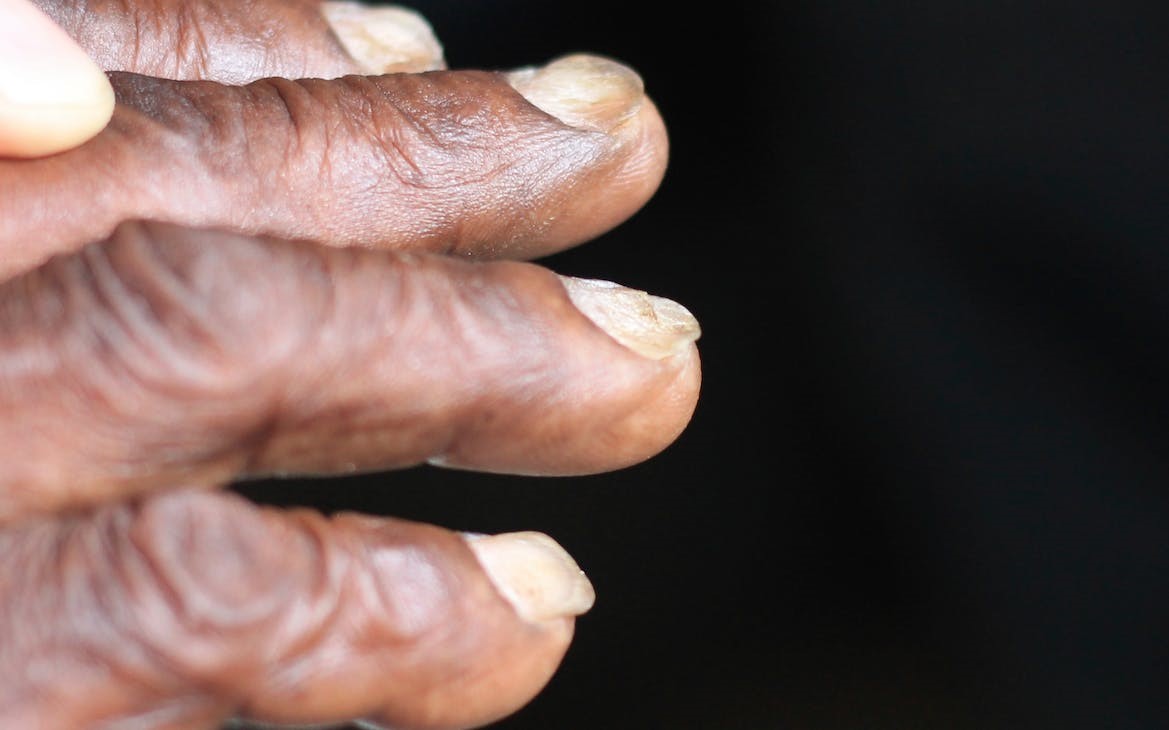
Figure 5.
Digital hypertrophic osteoarthropathy or digital clubbing
디지털 비대성 골관절증 또는 디지털 클러빙
Digital hypertrophic osteoarthropathy (HOA), or clubbing of the fingers, presents as an enlargement of the ends of the fingers (figure 6). It commonly occurs bilaterally as a primary or secondary condition. Primary HOA, or pachydermoperiostosis, is a hereditary condition.11 Secondary HOA is associated with disease, including lung, cardiovascular, inflammatory, cancer, thyroid, and liver diseases.12 The most common finding in children is HOA secondary to cystic fibrosis.12
디지털 비대성 골관절병증(HOA) 또는 손가락의 clubbing(곤봉지: 손가락 끝이 곤봉처럼 뭉툭해지는 것)은 손가락 끝이 커지는 증상을 나타냅니다(Figure 6). 일반적으로 1차(원발성) ,2차(이차성)로 진행되며 양측성으로 병변으로 발생합니다. 원발성 HOA 또는 후피골주증은 유전성 질환입니다. 이차성 HOA는 폐, 심혈관, 염증, 암, 갑상선 및 간 질환을 포함한 질병과 관련이 있습니다. 낭포성 섬유증은 소아에서 가장 흔한 질환이며 이차적으로 발생하는 HOA입니다.

Figure 6. Disital hypertrophic osteoarthropathy, commonly known as clubbed fingers
Terry’s nails 테리의 손톱
Terry’s nails present with a whitish or “ground glass” appearance, an absence of the lunula, and a normal or sometimes reddish-brown discoloration at the distal end of the nail (figure 7).
Terry 손톱은 희끄무레하거나 "반달모양? 갈라진 유리"모양으로 나타나며, 손톱의 가장 끝 부분에서 때때로 적갈색 변색을 보입니다(Figure 7).
This symptom is often secondary to cirrhosis, chronic renal failure, and congestive heart failure. There is no treatment as symptoms will decrease when the underlying condition improves.13
이 증상은 종종 간경화, 만성 신부전 및 울혈성 심부전에 이차적으로 발생합니다. 근본적인 상태가 호전되면 증상이 감소하기 때문에 치료가 없습니다.

Figure 7. Terry’s nails
Yellow nail syndrome 노란 손톱 증후군
Yellow nail syndrome (YNS) is a rare disorder that is associated with the pulmonary manifestations of chronic cough, bronchiectasia, and pleural effusion. Lower limb lymphedema due to lymphatic impairment and chronic sinusitis are also common causes.
YNS can resolve on its own and/or with the aid of medicaments such as antifungals and oral vitamin E.14 YNS(Yellow Nail Syndrome)는 만성기침, 기관지 확장증, 흉막삼출 등의 폐 증상을 동반하는 희귀질환입니다. 림프 손상 및 만성 부비동염으로 인한 하지 림프부종도 흔한 원인입니다. YNS는 자체적으로 항진균제 및 경구용 비타민 E와 같은 약제의 도움으로 해결할 수 있습니다.
Cyanosis 청색증
Central cyanosis of the nails is secondary to poor arterial oxygenation.15 Appearing also in the skin, tongue, and mucous membranes, this symptom should alert the dental team to further understand the patient’s medical history (figure 8).
손발톱의 중앙 청색증은 동맥의 산소 공급 부족으로 인해 이차적으로 발생합니다. 피부, 혀 및 점막에도 나타나는 이 증상은 치과 팀이 환자의 병력을 더 잘 이해하도록 경고해야 합니다(Figure 8).
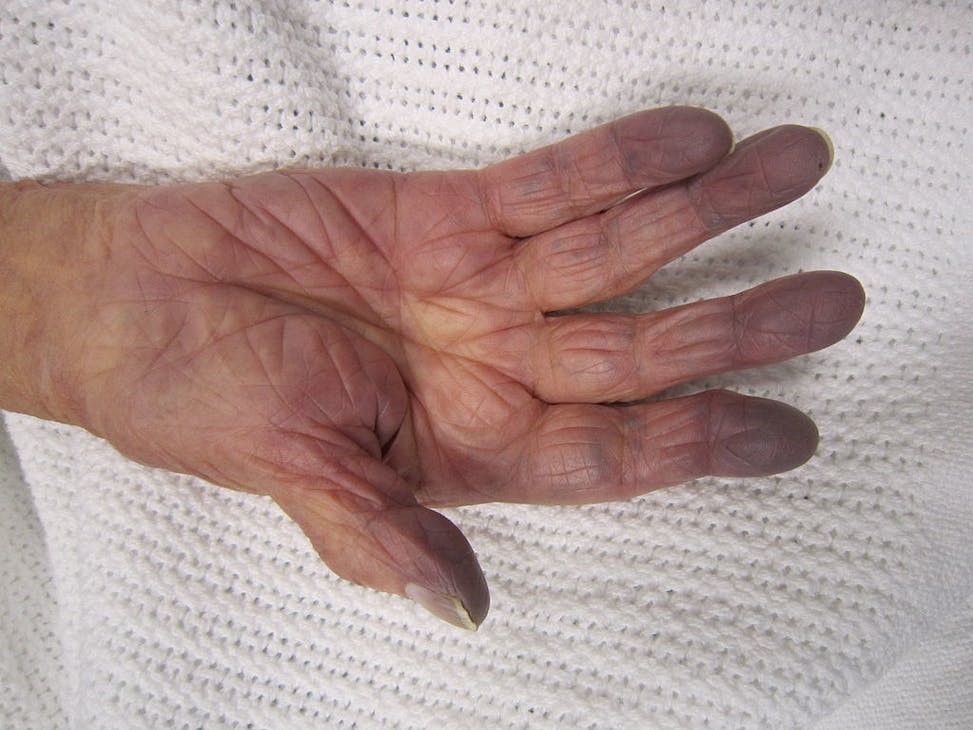
Figure 8: Cyanosis of the hand in someone with low oxygen saturations
Conclusion 결론
The nail beds, as a readily observable clinical feature, can present according to a person’s health at the time of the dental exam. Understanding differences among the clinical presentations can assist the dental hygienist and dentist in recognizing variations from normal that can support the comprehensive oral exam. Additionally, having a baseline medical history, dental history, extraoral and intraoral findings, hard- and soft-tissue findings, including the nail beds, can assist the dental team in observing changes in the clinical presentation of the patient’s oral and medical health. Especially useful at the initial visit, observation of the nail beds can serve both the patient and the dental team.
손톱 아래에서 쉽게 관찰 가능한 임상적 특징은 치과검진을 할 때 현재 그 사람의 건강 상태에 따라 나타날 수 있습니다. 임상적인 증상을 이해하면 치과위생사 및 치과의사가 전반적인 구강검진을 통하여 정상과 비정상의 차이를 구별하는데 도움이 될 수 있습니다. 또한 기본 병력, 치과 병력, 구강 외 및 구강 내 소견, 손톱 아래부분을 포함한 경조직 및 연조직 소견을 가지고 있으면 치과의료진이 환자의 구강 및 의료 건강의 임상 양상 변화를 관찰하는 데 도움이 될 수 있습니다. 초기 방문 시 특히 유용한 손톱 아래부분의 관찰은 환자와 치과의료진 모두에게 도움이 될 수 있습니다.
Editor's note: This article appeared in the December 2022 print edition of RDH magazine. Dental hygienists in North America are eligible for a complimentary print subscription. Sign up here.